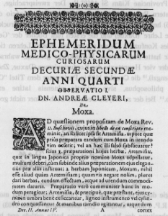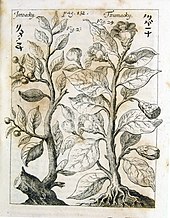Andreas Cleyer
Andreas Cleyer (born June 27, 1634 in Kassel , † between December 20, 1697 and March 26, 1698 in Batavia, now Jakarta , on Java ) was a German businessman , botanist , medic and Japan researcher.
Life
Andreas Cleyer was born as the son of Lieutenant Peter Kleier (also Kleiier) and his wife Agnes Amalia. Nothing is known about childhood and adolescence. He completed his studies, presumably in Marburg, with a licentiate in medicine (UML, utriusque medicinae licentiatus ), which entitles him to full professional practice.
On November 22, 1661 as a soldier ( adelborst , roughly equivalent to sea cadet ) in the service of the Dutch East India Company (VOC). After his arrival in Batavia he was initially employed as a hospital attendant. In 1665 he appears in the company's papers as a laboratory technician who deals with the delivery and manufacture of medicinal products. In the following year he got involved in the re-establishment of the Latin school and became its rector for a short time. After the fortress pharmacist's death in 1667, he took over his office, and in 1668 the city and hospital pharmacy was added. He then held a key position in the company's medical system. He managed to run both facilities independently. Since he also ran his own herb gardens and used inexpensive drugs from the company's catchment area, he was soon financially successful. In 1680 he became a member of the Council of Justice.
In 1682 he took over the management of the Dejima branch in Nagasaki (Japan) for one year . This post was coveted because it enabled a considerable additional income through small private trading companies. Cleyer and George Meister , whom he had hired as gardeners and overseers for his medicinal gardens in Batavia, also began to look for useful plants in Japan. Although the Europeans were monitored and, if possible, prevented from exploring the country and its people, botany has been allowed since the late 1960s because the Japanese authorities were also interested in the development of indigenous resources. Cleyer made the first noteworthy western studies of the flora of Japan. During his second stay in Japan from 1685 to 1686 there were all sorts of problems with his private trade, which is why the Japanese authorities forbade him from any further landings.
However, the fortune acquired in Batavia and Japan allowed him to retire from the company. Cleyer did not return to Europe, but stayed in Batavia, devoted himself to the study of Malaysian botany and held some honorary positions. A number of German compatriots such as Heinrich Muche , Johann Wilhelm Vogel or Johann Konrad Rätzel mention Cleyer in their travel books.
Services
Cleyer carried out extensive botanical inventories in East and Southeast Asia and at the same time collected zoological and medical information. His correspondence and the close contact with the German Leopoldina , to which he belonged from November 8, 1678 , drew the attention of many scholars to the Japanese flora. The oldest illustrations of Japanese plants in European printed works come from Cleyer; he was the first to explain the nature of the Japanese moxa described by Hermann Buschoff . Cleyer also exerted a strong influence on Engelbert Kaempfer when he was preparing for the trip to Japan in Batavia in 1689. Kaempfer's research on the flora of the island kingdom goes back to Cleyer's suggestions. Cleyer also made sure that the Clavis Medica of the Polish Jesuit Michael Boym , through which he became known with the Chinese pulse theory, as well as the Specimen Medicinae Sinicae , a collection of translations from the pen of Philippe Couplet (1623-1693) and other Jesuits of the China Mission, were published. An extensive collection of Japanese plant watercolors, which he sent to the doctor, botanist and sinologist Christian Mentzel in Berlin, is now guarded by the Berlin State Library .
Fonts
- Specimen Medicinae Sinicae, sive Opuscula Medica ad Mentem Sinensium . Zubrodt, Frankfurt am Main 1682. (Cleyer is merely the editor of this collection of translations prepared by the Jesuits in China.)
- Clavis medica ad Chinarum doctrinam de pulsibus / authors Michaele Boymo… in lucem Europaeam produxit Cl. Dn. Andreas Cleyerus… . Norimbergae, 1686.
- Diary of the office in Nagasaki on Deshima Island, Oct. 20, 1682–5. Nov 1682 . (Edited by Eva S. Kraft) Bonn 1985. ISBN 3-922700-05-5
- Observations by Cleyer in the “Miscellanea curiosa medico-physica Academiae naturae curiosorum sive Ephemerides Germanicae” (after Michel, 1991)
- 1683: Decuria II, Annus I:
- Observatio 16, De Ovo gallinaceo, cum serpentis imagine in testâ.
- Observatio 17, De Ovo gallinaceo praegnante & epate gallinarum insigni.
- Observatio 18, De Corporibus sphaericis permultis in ventriculo humano inventis.
- 1684: Decuria II, Annus II:
- Observatio 5, De Elephantia Javae novae.
- Observatio 7, De Serpente magno Indiae Orientalis, Urobubalum deglutiente.
- Observatio 8, De Nube pyramidali in Oceano attractiva.
- 1685: Decuria II, Annus III:
- Observatio 13, De S.Thomae Christianis Indiae Or. Pedibus strumosis.
- 1686: Decuria II, Annus IV:
- Observatio 1, De Moxa.
- Observatio 2, De Radice Gensingh.
- Observatio 3, De Catechu.
- Observatio 4, De Herba Thee.
- Observatio 5, De Fructu Pineapple.
- Observatio 6, De Cinnamomo & Cassia lignea.
- Observatio 92, De Japanensium arbusculis Tzudzinsic dictis.
- 1687: Decuria II, Annus V:
- Observatio 40, De Arbore laccifera Japanensi Fasnoky sive Namra.
- Observatio 41, De Arbore Mami Itabo Japonensium.
- 1688: Decuria II, Annus VI:
- Observatio 49, De Cicadis Indicis.
- Observatio 52, De Planta Japanica Vinganfana.
- Observatio 53, De Duabus plantis aquaticis Japanensibus Koëbe & Fasnofana.
- Observatio 54, De Canschy & Fiewa Japanensium arboribus.
- 1689: Decuria II, Annus VII:
- Observatio 70, De Plantis Japanensibus Isnoacky, Germ. Eyserholz / & Tsumacky.
- Observatio 71, De Plantis Japanensibus Cumi Gummi & Miaco Bana.
- Observatio 72, De Plantis Japanensibus Kyrama & Fickofax.
- Observatio 73, De Plantis Japanensibus Nifum Schin 'Srogat, Mominoky & Feggo
- 1690: Decuria II, Annus VIII:
- Observatio 21, De Ceto minore ambrophago.
- Observatio 22, De Monstrosa animalia.
- Observatio 190, De Plantis Japanensibus Mitznofana & Fatasiro.
- Observatio 191, De Floribus Japanensibus Kanako Juri & Jama Juri.
- Observatio 192, De Arboribus Japanensibus Fisakaky & Tsutta.
- 1691: Decuria II, Annus IX:
- Observatio 75, De Plantis Japanensibus Din nanscho & Omodto.
- Observatio 76, De Floribus Japanensibus Vohsnofana & Ghimi.
- Observatio 77, De Arboribus Japanensibus Kutzinèsch & Tobera-Nocky.
- 1692: Decuria II, Annus X:
- Observatio 35, De Opio Aphrodisiaco.
- Observatio 36, De Arboribus Japonensium Itabe & Hambu.
- Observatio 37, De Arbore Camphorifera Japonensium Kusnoky dicta.
- Observatio 38, De Plantis Japonensium Ran & Schoboe.
- 1695: Decuria III, Annus II:
- Observatio 179, De Plantis Japanensibus Jamaran & Decku.
- Observatio 180, De Fruticibus Japanensibus Tzinsinqua & Daniwathas.
- Observatio 181, De Floribus Japanensibus Schinobu & Tzooschinkiku.
- Observatio 182, De Arboribus Japanensibus Meehebii & Insur.
- 1696: Decuria III, Annus III:
- Observatio 118, De Arbore Japonensium Tschooditsoo sive Tschoot-Itzu.
- Observatio 119, De Floribus Japonensium Kuko sive Asangu & Zuri-Jani.
- Observatio 120, De Plantis Japonensium Zumani & Jamiuncka sive Jamamiuncka.
- 1700: Decuria III, Annus V & VI:
- Observatio1, De Plantis Japonensibus Joosie.
- Observatio 2, De Arboribus Japonensibus Gummy & Fiaku Schyqua.
- Observatio 3, De Fruticibus Japonensibus Tsingkikoe & Fana datzibana.
literature
- August Hirsch: Cleyer, Andreas . In: Allgemeine Deutsche Biographie (ADB). Volume 4, Duncker & Humblot, Leipzig 1876, p. 332.
- Hans Körner: Cleyer, Andreas. In: New German Biography (NDB). Volume 3, Duncker & Humblot, Berlin 1957, ISBN 3-428-00184-2 , p. 290 f. ( Digitized version ).
- Eva Kraft: Andreas Cleyer. Diary of the office in Nagasaki on the island of Deshima October 20, 1682 - November 5, 1683 . Bonn 1985.
- Wolfgang Michel: An East Indian missive - Andreas Cleyer's letter to Sebastian Scheffer of December 20, 1683. In: Dokufutsu Bungaku Kenkyu , No. 41 (Fukuoka, August 1991), pp. 15-98.
- Wolfgang Michel: "The East Indian and neighboring kingdoms, a brief explanation of the noblest rarities" - New finds on the life and work of the Leipzig surgeon and trader Caspar Schamberger (1623–1706). Kyushu University, The Faculty of Languages and Cultures Library, No 1. Fukuoka: Hana-Shoin, 2010, pp. 69-78. ( ISBN 978-4-903554-71-6 )
- Johann Daniel Ferdinand Neigebaur : History of the imperial Leopoldino-Carolinische German academy of natural scientists during the second century of its existence. Friedrich Frommann, Jena 1860, p. 193 .
- Volker Zimmermann: Cleyer, Andreas. In: Werner E. Gerabek , Bernhard D. Haage, Gundolf Keil , Wolfgang Wegner (eds.): Enzyklopädie Medizingeschichte. De Gruyter, Berlin / New York 2005, ISBN 3-11-015714-4 , p. 264.
swell
- Arrival of the bush peonies in Europe - Walter Good
- Biographical encyclopedia of German-speaking doctors . Volume 1, p. 107 Munich 2002.
Web links
- Literature by and about Andreas Cleyer in the catalog of the German National Library
- Publications by and about Andreas Cleyer in VD 17 .
Individual evidence
- ↑ Kraft (1985), p. 34f.
- ↑ Kraft (1985), p. 35.
- ↑ a b c d Wolfgang U. Eckart : Andreas Cleyer , in: Wolfgang U. Eckart and Christoph Gradmann (eds.): Ärztelexikon. From antiquity to the 20th century , 1st edition 1995 CH Beck Munich p. 95f., Medical dictionary. From antiquity to the present , 2nd ed. 2001, p. 78, 3rd ed. 2006 Springer Verlag Heidelberg, Berlin, New York, p. 81. Ärztelexikon 2006 , doi : 10.1007 / 978-3-540-29585-3 .
- ↑ Kraft (1985), p. 36f.
- ↑ Kraft (1985), p. 38
- ↑ Michel (2010), p. 71.
- ↑ Member entry of Andreas Cleyer at the German Academy of Natural Scientists Leopoldina , accessed on March 25, 2016.
| personal data | |
|---|---|
| SURNAME | Cleyer, Andreas |
| BRIEF DESCRIPTION | German businessman, botanist, physician and Japan researcher |
| DATE OF BIRTH | June 27, 1634 |
| PLACE OF BIRTH | kassel |
| DATE OF DEATH | between December 20, 1697 and March 26, 1698 |
| Place of death | Batavia, today Jakarta |

